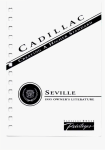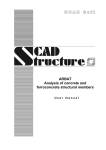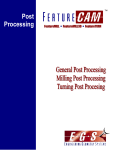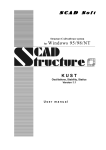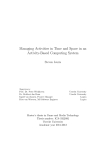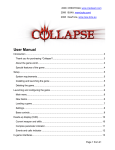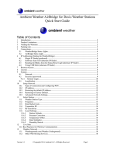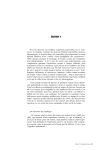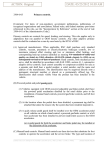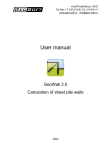Download SCAD Soft
Transcript
SCAD Soft ZAPROS Analysis of members of foundations and beds User manual UDC 737.30 Team of authors V.S. Kravchenko, E.Z. Kriksunov, M.A. Perelmuter, L.N. Skoruk ZAPROS. Analysis of foundations and beds. USER MANUAL. Version 1.1. The manual presents a description of functionality of the ZAPROS software application, its controls, and recommendations on its use. The software is oriented at structural design engineers with basic computer skills. SCAD Soft, 2006 © Table of contents Table of contents 1 Introduction ..................................................................................................................................................... 5 The main window .......................................................................................................................................5 Menus .........................................................................................................................................................6 Settings .......................................................................................................................................................7 Working with tables ...................................................................................................................................8 Saving data .................................................................................................................................................9 Information modes ........................................................................................................................................ 10 2.1 Deformation limits for foundation............................................................................................................10 2.2 Design resistance of subgrade soil............................................................................................................10 2.3 Soil characteristics....................................................................................................................................10 2.4 Service factors ..........................................................................................................................................10 Foundations ................................................................................................................................................... 12 3.1 Foundation careen ....................................................................................................................................12 3.1.1 General notes ..................................................................................................................................12 3.1.2 Limitations of the current version ...................................................................................................12 3.1.3 Data preparation..............................................................................................................................12 3.1.4 Results of analysis...........................................................................................................................13 3.2 Foundation settlement ..............................................................................................................................14 3.2.1 General notes ..................................................................................................................................14 3.2.2 Algorithm of the analysis................................................................................................................14 3.2.3 Limitations of the current version ...................................................................................................15 3.2.4 Data preparation..............................................................................................................................15 3.2.5 Results of analysis...........................................................................................................................16 3.3 Subgrade reaction coefficients..................................................................................................................17 3.3.1 General notes ..................................................................................................................................17 3.3.2 Data preparation and analysis .........................................................................................................18 3.4 Ultimate pressure in deformation analysis................................................................................................18 3.4.1 General notes ..................................................................................................................................18 3.4.2 Data preparation and analysis .........................................................................................................18 Piles............................................................................................................................................................... 20 4.1 Service factors for piles ............................................................................................................................20 4.2 Range of piles ...........................................................................................................................................20 4.3 Calculation of load-bearing ability of a pile .............................................................................................20 4.3.1 Data preparation..............................................................................................................................20 4.3.2 Results of analysis...........................................................................................................................22 4.3.3 Limitations of the current version ...................................................................................................22 4.4 Analysis of pile.........................................................................................................................................22 4.4.1 Data preparation..............................................................................................................................22 4.4.2 Results of analysis...........................................................................................................................23 4.4.3 Limitations of the current version ...................................................................................................24 4.5 Pile settlement ..........................................................................................................................................24 4.5.1 Data preparation..............................................................................................................................24 4.5.2 Results of analysis...........................................................................................................................24 4.5.3 Limitations of the current version ...................................................................................................24 Field testing of piles ...................................................................................................................................... 25 5.1 Dynamic pile testing.................................................................................................................................25 5.1.1 Data preparation..............................................................................................................................25 5.1.2 Results of analysis...........................................................................................................................26 5.1.3 Limitations of the current version ...................................................................................................26 5.2 Testing with a sample pile ........................................................................................................................26 5.2.1 Data preparation..............................................................................................................................26 5.2.2 Results of analysis...........................................................................................................................27 5.2.3 Limitations of the current version ...................................................................................................27 5.3 Testing with a probing pile.......................................................................................................................27 5.3.1 Data preparation..............................................................................................................................27 5.3.2 Results of analysis...........................................................................................................................28 5.4 Static probing ...........................................................................................................................................28 5.4.1 Data preparation..............................................................................................................................29 5.4.2 Results of analysis...........................................................................................................................29 APPENDIX ................................................................................................................................................... 30 1.1 1.2 1.3 1.4 1.5 2 3 4 5 6 3 6.1 6.2 7 Formula calculator....................................................................................................................................30 Converter of measurement units...............................................................................................................30 References ..................................................................................................................................................... 32 Introduction 5 One needs a foundation not because it’s good to live in a basement V.Boss “Lectures on mathematics: from Diophantos to Turring”. Vol. 6” 1 Introduction The ZAPROS software application does various kinds of analyses and checks of elements of beds/foundations for compliance with requirements of SNiP 2.02.01-83* [7] and SP 50-101-2004 [9], SNiP 2.02.03-85 [10] and SP 50-102-2003 [11]. The application also provides reference data commonly used in the engineering of beds and foundations. The first version of the software implements modes for analysis of deformations of rectangular foundations, calculating the inclination of this type of foundations, calculating the subgrade reaction coefficients and the safe working pressure (a design resistance of subgrade soil). The controls and procedures used to prepare data and to document results, which are implemented in the application, are exactly the same as those in other computer-aided design and analysis applications included in the SCAD Office® software package. The applications are based on common multiple-tab windows and dialog boxes. To switch to a mode, click on its tab or use an appropriate menu item. 1.1 The main window When the application is started, the first thing seen on the screen is its main window that displays a map of buttons for entering various working modes (Fig. 1), choosing a particular design code, and customizing the application’s settings. Fig. 1. The main window of the application A particular set of design regulations can be selected from a list. The set of regulations that has been selected is displayed in the bottom left corner of the active mode’s window. If the selected design code is SP 50-101-2004, then the analysis of piles will comply with SP 50-102-2003 automatically. 5 6 Introduction The modes are invoked by their particular buttons and can be either reference (included in the Information group) or analytic (included in the Analysis group). The reference/information modes include the following: Deformation limits for foundations — helps browse limit values of the relative difference of settlement, careen, and an average or maximum settlement for various types of structures listed in Appendix 4 to SNiP 2.02.01-83* (Appendix E to SP 50-101-2004); Design resistance of subgrade soil — presents information about the design resistance of various kinds of soils listed in Appendix 3 to SNiP 2.02.01-83* (Appendix A to SP 50-101-2004); Soil properties — presents information given in Appendix 1 of SNiP 2.02.01-83* (Appendix G to SP 50101-2004); Service factors — provides information from Table 3 of SNiP 2.02.01-83* (Table 5.2 of SP 50-101-2004). The Foundations group contains the following actions: Foundation careen — determines the careen of a rectangular foundation caused by loads upon it; Foundation settlement — makes a strain analysis of beds of post and strip foundations, rectangular in their plane, and stiff slabs; Subgrade reaction coefficients — calculates the reaction coefficients of a bed that consists of a finite number of layers, each being linearly deformable and constant in its thickness; Limit pressure for strain analysis — calculates the limit pressure under the foundation’s underside (a design resistance of soil). The Piles group includes two information modes — Service factors for pile and Range of piles, together with the following analysis modes: Load-bearing ability of pile — calculates the load-bearing ability of a pile that resists to a vertical load; Pile analysis — calculates the stability coefficient of the foundation, the minimum and maximum bending moment and the shear force in a given section of the pile, and some other numbers related to the pile; Pile settlement — calculates the settlement of the pile loaded vertically. The Pile field tests group consists of: Dynamic tests of piles — load-bearing ability analysis of piles after results of dynamic tests; Testing with sample pile — calculation of the load-bearing ability of a driven (field) friction pile that resists to compression, after results of tests of soil with a sample pile; Testing with probing pile — calculation of the load-bearing ability of a driven (field) friction pile that resists to compression, after results of tests of soil with a probing pile; Static probing — calculation of the load-bearing ability of a driven (field) friction pile that resists to compression, after results of tests of soil with static probing (penetration test). When you invoke any of the said modes, a multiple-tab dialog box appears where you enter data and browse results. 1.2 Menus Menus are used to customize the application’s settings, to invoke a desired working mode, or to launch an auxiliary tool. There are five menus in the application’s environment: File, Modes, Settings, Tools, Help. The File menu contains the following items: Menu — switches from any working mode to the main window; Exit — finishes the current working session. The Modes menu can be used to launch any of the information or analysis modes implemented in the application (its items duplicate the buttons of the main window). The Settings menu calls up the Application Settings dialog box where you customize various settings of the application (it duplicates the respective button of the main window). The Tools menu helps launch a standard Windows calculator, a formula calculator, and a measurement unit converter. The References menu provides help on how to use the ZAPROS application, how to use the Windows help system, and version information (No. of the version and the date of last modification). Auxiliary tools are described in the Appendix. Introduction 7 1.3 Settings The Application Settings dialog box (Fig. 2) is called up by the Settings menu or by the respective button at the bottom of the main window. It contains three tabs: Units of Measurement, Report and Languages, Visualization. Fig. 2. The Units of Measurement tab of the Application Settings dialog box The Units of Measurement tab is used to set up physical units of measurement which will be used to enter source data and to review results of the analysis. The units of measurement can be altered at any time while working with the application. To set up simple units such as linear sizes or forces, use drop-down lists. In cases when the units are complex, the drop-down lists display the current ones, and the settings are made in the Set up Units of Measurement dialog boxes (Fig. 3). The dialogs are called up by the button to the left from the drop-down list. To specify the desired units, choose appropriate items from the drop-down lists available in the dialog box and then click OK to exit the dialog. The Report and Languages dialog box (Fig. 4) is used is used to choose a language for the user interface, a form of representation for the report, a format for the report document etc. It includes the following controls: View/Edit — calls up a viewer/browser application for viewing the report, associated with the report’s specific format and filename extension; Print — prints out the report without displaying it on the screen; Report Type — a drop-down list suggests to choose a file format for the report document. The RTF files come in two versions: Word 7 (Word Pad) or Word 97 and newer; the DOC, HTML, and PDF files are also available. To view or print the PDF files, you need to have the Adobe Acrobat Reader application installed (the application is freeware and can be downloaded at http://www.adobe.com ); the Paper, Margins, and Orientation groups are used to customize the format of the report document; the Headers/Footers group is used to refer to an RTF file that contains headers and footers to be used in the report. This file can be prepared by a user. 7 8 Introduction Fig. 3. The Set up Units of Measurement dialog box Fig. 4. The Report and Languages tab of the Application Settings dialog box The Visualization tab is used to choose a font for the text messages displayed on the screen and printed out to the report. Double left clicking the line with the currently selected font opens the standard Font dialog box where the font is to be set up. 1.4 Working with tables The Preview button Fig. 6. An information dialog that depicts specified layers of soil Fig. 5. An example table of soil properties In most cases, source data for any kind of analysis are provided as tables (Fig. 5). The following general rules are used for working with the tabular data: the data are entered in a table as decimal numbers; a particular separator between the integral and fractional parts of the number (either comma or period) depends on the settings of the Windows environment; in cases when the number of rows in the table is assigned by the user, the table has the Add and Delete buttons next to it; the former adds a new row after the selected one, and the second deletes one or more selected rows; to select one or more successive rows, place the mouse pointer on the No. of the first one, click and hold the left mouse button, and drag the pointer across the Nos. of the rows to be selected; to switch between the cells of the table, press the Tab key on your keyboard; if the information thus entered can be represented in a graphical form, then after providing the data you can click the Preview button to open an information dialog box and browse the data conveniently (Fig. 6). Introduction 9 New rows are added after the selected one, therefore you need to do the following to add a new row before the very first one of the table: o select the first row in the table and click the Add button to add a new one after it; o select the first row in the table and press the Ctrl+Insert keys together; this will copy the contents of the first row to the Clipboard; o select the second (new) row of the table and press the Shift+Insert keys together; this will insert the contents of the Clipboard in the cells of the second row, and now the first row can be filled with other data as necessary. The sequence described above can be used also to copy one or more selected rows of a table. 1.5 Saving data All analysis modes make it possible to save the entered data to an external file. To do it when in a particular mode, choose the File|Save As menu item. This will open a standard Windows dialog box for choosing a folder and a file to store the data in. The filename and the extension are specified by the user. To load the previously saved data later, use the menu item File|Open. 9 10 Information modes 2 Information modes The reference (information) modes provide data listed in the SNiP documents. All values in the respective tables are presented in the same units of measurement as in the design codes; they do not depend on the settings of the application. 2.1 Deformation limits for foundation This mode (Fig. 7) provides data from Appendix 4 to SNiP 2.02.01-83* and Appendix E to SP 50-101-2004. Fig. 7. The Deformation Limits for Foundation dialog box Fig. 8. The Design resistance of Subgrade Soil dialog box 2.2 Design resistance of subgrade soil Information presented by this mode (Fig. 8) includes data from Tables 1 through 6 of Appendix 3 to SNiP 2.02.01-83* (Appendix А to SP 50-101-2004), namely, the design resistance of coarse debris, sand, pulverescent clay, collapsible and filling soil, and also of backfill soil. 2.3 Soil characteristics This information includes rated values of strength and strain characteristics of soils (Fig. 9) given in Tables 1 through 3 of Appendix 1 to SNiP 2.02.01-83* and Appendix G to SP 50-101-2004. 2.4 Service factors This mode (Fig. 10) presents data from Table 3 of SNiP 2.02.01-83* (Table 5.2 of SP 50-101-2004). Information modes Fig. 9. The Soil Characteristics dialog box 11 Fig. 10. The Service Factors dialog box 11 Foundations 3 Foundations 3.1 Foundation careen 3.1.1 General notes The mode calculates the careen of a foundation rectangular in plan and subjected to loads from walls and columns, loads upon adjacent areas, and pressure from adjacent foundations in compliance with requirements of SNiP 2.02.01-83* and recommendations of "Guide to the design of foundations of structures (to SNiP 2.02.01-83)" by Gersevanov Research Institute for Foundations and Underground Structures, USSR State Committee for Construction (1986, Sec. 2.233-2.245, 2.212-2.218) [8], and SP 50-101-2004 [9]. The careen caused by the loads upon the foundation is calculated both with and without taking into account the soil’s back pressure along the side surface of a pedestal footing (Section 17.2.241 of “Guide...” recommends to allow for the soil back pressure along the side surface of the pedestal footing if the underground part of the foundation is higher than 5 m; SP 50-101-2004 does not regulate the issue of soil back pressure along the side surface). Other calculable parameters include: o the depth of the compressible bulk of soil; o the bending moments at the foundation’s underside level; o the edge pressure under the foundation’s underside (maximum and minimum); o the corner pressure under the foundation’s underside (maximum and minimum); o the nonuniform compression coefficient for soil under the underside; o the depth of the foundation’s rotation center; o the ordinates of the diagram of the soil back pressure along the side surface of the pedestal footing, in eleven cross-sections. All results are provided for two mutually perpendicular planes. The mode can be used to analyze pile or strip footing of industrial or residential buildings, or various other kinds of structures. The stiffness of structures above the foundation is not taken into account. The size of the foundation’s underside is not limited. The bed can consist of layers of soft (non-rocky) soil of an uneven depth. 3.1.2 Limitations of the current version The maximum number of adjacent foundations is 14. The maximum number of loads upon adjacent areas is 10. The number of soil layers below the underside is 8. 3.1.3 Data preparation Source data for the analysis are prepared in the Foundation Careen multiple-tab dialog box (Fig. 11) which consists of the following tabs: General — serves to specify numerical characteristics of a foundation in question and stresses that act on the top of it, together with the characteristics of adjacent foundations and values of normal forces acting on the adjacent foundations at their top levels. This tab is also used to specify loads upon adjacent areas defined as rectangular regions. To define each area, specify coordinates of its center’s binding point, sizes of the rectangle, and the distributed load’s value. The weight of both soil and the foundations is taken into account by default. To be sure to calculate the careen caused by the adjacent foundations and the loads upon the adjacent areas, specify at least one load. The information entered can be checked using the Preview buttons, . Jumps — this is used to specify geometric characteristics of the foundation and its depth with respect to the level of planing (or floor) and the natural relief (Fig. 12). The geometric characteristics include the foundation’s height, the number/height/sizes of the jumps (for strip foundations, the number of jumps is taken equal to one, and only the first jump’s height needs to be specified). In cases when the side back pressure of soil is ignored, no data about the jumps are needed. 12 Foundations Fig.11. The General tab of the Foundation Careen dialog box Fig.12. The Jumps tab of the Foundation Careen dialog box Soil — this is used to specify design characteristics of soil (for deformation analysis) under the foundation’s underside and characteristics of soil above the underside (Fig. 9). To check the information you have specified on any of the listed tabs, use the Preview buttons. When the parameters of the foundations are being analyzed, the data check window displays the underside sizes A and B of each foundation (including the current one) and their respective normal force values (Fig. 13). When the loads upon the adjacent areas are being analyzed, the load fields are displayed against the background of the foundations, and a bounding box is shown for each load together with its magnitude (Fig. 14). Fig.13. The Foundations data check window 3.1.4 Fig.14. The Floor Load data check window Results of analysis The analysis is launched by clicking the Calculate button. Results of this calculation are displayed, in units of measurement according to the application’s settings, as tables on the Results tab (Fig. 15) and include the following: o the careen of the foundation toward the X and Y axes, caused by the floor loads and the effect of the adjacent foundations; o the careen of the foundation toward the X and Y axes, caused by the loads upon the foundation without the soil back pressure; o the overall careen of the foundation toward the X and Y axes (caused by the working load on the floor, the effect of the adjacent foundations, and the loads upon the foundation itself), no back pressure of soil taken into account; o the careen of the foundation toward the X and Y axes, taking into account the soil back pressure and the loads upon the foundation; o the total careen of the foundation toward the X and Y axes; o the thickness of the compressible bulk of soil; o the bending moments at the underside level toward the X and Y axes; o the maximum edge pressure below the foundation’s underside, toward the X and Y axes; 13 Foundations the minimum edge pressure below the foundation’s underside, toward the X and Y axes; the maximum and minimum corner pressure below the foundation’s underside; the nonuniform compression coefficient for soil below the underside, in the vertical direction, toward the X and Y axes (formula (84) of the “Guide...”); o the depth of the foundation’s rotation center toward the X and Y axes. Also, if the analysis takes account of the soil back pressure from the sides, the Results tab will display diagrams of the back pressure on the side surface vs. the depth, toward the X and Y axes. If the back pressure along the side surface exceeds the design resistance of soil, a message indicating the axis will be generated. o o o Fig. 15. The Results tab of the Foundation Careen dialog box Fig. 16. A representation of the report in the MS Word word processor window A report is generated after the results of the analysis (the Report button serves for that); it contains tables of the source data and the analysis results. If the analysis has taken account of the soil back pressure from the sides, the report will include a table of ordinates of the back pressure on the side surface vs. the depth diagrams, in the X and Y directions, and the design resistance of soil in eleven cross-sections from top downward. The report will be opened automatically by an application associated with the format, that has been defined in the ZAPROS application settings (Fig. 16). 3.2 Foundation settlement 3.2.1 General notes The mode is used to make a deformation analysis of a piled or strip foundation rectangular in plan, or a stiff foundation slab. The mode calculates the values of an average settlement and a slump of soil, checks that the pressure at the foundation’s underside level and that at the top of all soil layers corresponds to the design resistance of soil in compliance wih SNiP 2.02.01-83* and "Guide to the design of foundations of structures (to SNiP 2.02.0183)"-1986. If the pressure at the foundation’s underside level exceeds the design value, the settlement beyond the linear stress vs. strain law in soil will be calculated according to Section 2.226 of the "Guide to...” to SNiP... and to SP 50-101-2004. To calculate the settlement, the design model of the foundation is assumed to be a linearly deformable halfspace or a finite-thickness layer. Collapsible soils are classified into Type 1 and Type 2. The deformation analysis of the foundation takes account of the pressure caused by adjacent foundations, the working load upon the structure’s floor, the presence of a basement, groundwater and confining beds. The results include values of the above listed deformations and an indication whether the requirements/criteria for the foundation are met by the deformation analysis that has been done. 3.2.2 Algorithm of the analysis The application chooses the design model for a foundation automatically — either a linearly deformable halfspace or a finite-thickness layer. To make a choice, it begins with an analysis that uses the linearly deformable halfspace model of the foundation and calculates the deformations and the depth of the compressible bulk. This model is replaced by the finite-thickness layer model in the case when the compressible bulk contains a layer where Е > 10000 tons/m2 so its thickness should satisfy Condition 32(6) of the "Guide to the design of foundations for structures". If both sizes of the underside exceed 10.0 m, the design thickness of the linearly deformable layer will be calculated (according to Sec.2.220 of the "Guide ..."), and within its limits the moduli of deformation will be analyzed. The elastic layer model will be adopted if the overall thickness of layers with the modulus of deformation Е < 1000 tons/m2 does not exceed 20% within the design thickness of the elastic layer. The design thickness of the 14 Foundations elastic layer will be increased by the thickness of the layer that has the modulus of deformation Е < 1000 tons/m2, if the latter layer is located below the bottom of the elastic layer and its thickness is not greater than 5.0 m. If the thickness of the elastic layer is too big, the analysis will be based on the elastic half-space model. The analysis of deformations in the foundation takes account of the effect of presence of adjacent foundations. Additional pressure caused by the adjacent foundations is calculated by the method of corner points in accordance with Sec.3 of Appendix 2 to SNiP 2.02.01-83*. The undersides of the main and adjacent foundations are assumed to be located at the same level, and their natural pressure is also supposed to be the same, though the loads and the sizes of the undersides are different. The additional pressure caused by working load on the ground floor of the building is calculated similarly to the adjacent foundations; their true level of application is used. The pressure caused by working load dies out with depth, while the pressure of the made ground layer is equal to the weight of a column of this layer with the area of 1 square meter at any depth because the made layer is assumed to cover a significant area. The settlement can be affected much by the presence of working load upon the building’s ground floor, if the load is applied to a big enough area. According to SNiP 2.02.01-83*, in the calculation of settlement the depth of the compressible bulk of soil is counted to the level at which the natural pressure is five times greater than the additional one. However, if the soil layer below that level has the modulus of deformation Е < 500 tons/m2, then the layer will be included in the boundary of the compressible bulk. If the layer is very thick, the boundary of the compressible bulk will be counted to the level at which the natural pressure is ten times greater than the additional one. SP 50-101-2004 (п. 5.5.41) assumes that the lower boundary of the compressible bulk of the foundation is at the level where the natural pressure is five times greater than the additional one with the width of the foundaiton less than or equal to 5 m (k = 0.2), or two times greater with the width greater than 20 m (k=0.5). When the width of the foundation is greater than 5 m up to 20 m, the value of k is extrapolated. The accuracy of calculating the depth of the compressible bulk is up to 1 mm, and the lowest specified layer is assumed to have a large thickness. The strength of soil is checked to comply with Sec.2.48 of SNiP 2.02.01-83* at the top levels of all specified layers of soil, except for the underside of the foundation. The slump of the foundation is assumed to remain within the given slump thickness. With the type-1 collapsibility, the slump is calculated as if it were caused only by loads upon the foundation and for all specified soil layers; with the type-2 collapsibility, the loads upon the foundation and the self-weight of soil are taken into account, the latter up to the level at which the natural pressure is equal to the initial slump pressure. The lower boundary is the level specified by the user. The value of the initial slump pressure of soil layers is used to calculate the collapsibility coefficient. The collapsibility coefficient is assumed to be 1 for second-type collapsibility. 3.2.3 Limitations of the current version The maximum number of adjacent foundations is 14. The maximum number of loads upon adjacent areas is 10. The maximum number of soil layers below the underside is 8. The maximum number of slumping soil layers is 11. 3.2.4 Data preparation Fig.17. The General tab of the Foundation Settlement dialog box Fig.18. The Loads on Floor tab of the Foundation Settlement dialog box Source data for the analysis are specified in the Foundation Settlement multiple-tab dialog box which contains the following tabs: 15 Foundations General (Fig. 17) — this tab is used to specify characteristics of the main foundation and its adjacent ones, together with normal forces, N, for the same foundations. To check the information entered, use the Preview button. Loads On Adjacent Areas — this tab is used to set up loads in the form of rectangular areas. Each area should be defined by its center’s coordinates, sizes of the rectangle’s sides, and the value of the distributed load (Fig. 18). Soil — this tab is used to specify design characteristics of soils below underside for the purpose of deformation analysis (Fig. 19a), and additional characteristics related to slump (Fig. 19b) the set of which depends on the collapsibility type. In particular, for the type-1 collapsibility the number of overall pressure numbers, Р, is set to something from two to five, and for the type-2 collapsibility it will be three to five. Also, the second type of collapsibility requires that the first value of the relative collapsibility of soil (δ1) should be one at the natural pressure. Fig.19a. The Soil tab of the Foundation Settlement dialog box, no slump allowed for Fig.19b. The Soil tab of the Foundation Settlement dialog box, slump allowed for When you have entered all the data required by the said tabs, you can check the data using the Preview button similarly to the foundation careen calculation mode. 3.2.5 Results of analysis To start the analysis, click the Calculate button. Results of the analysis will be displayed as tables, in the units of measurement specified by the application’s settings, on the Results tab (Fig. 20) and include the following values: o the design resistance of soil at the level of the foundation’s underside; o the average pressure, caused by loads, at the foundation’s underside level; o the settlement of the foundation; o the slump caused by load; o the slump caused by the soil weight; o the sum of the settlement and the slump; o the depth of the compressible settling bulk; o Winkler’s subgrade reaction coefficient. Also, messages are generated which indicate the type of the foundation’s design model used to calculate a joint deformation of the foundation and its superstructure — either a linearly deformable half-space or a linearly deformable layer. Other messages characterize the obtained results according to various criteria, for example, “Check per Sec. 2.41 of SNiP 2.02.01-83* for the underside level is passed (not passed)”, “Conditions for deformations are fulfilled”, “Settlement exceeds allowable value”, “Condition for weak layer is not fulfilled”, “Sum of settlement and slump is greater than allowed”. Additionally printed information includes data about soil layers (the maximum number of layers is 20). If the foundation is modeled by an elastic half-space, the following information is output for each layer: o the thickness of the layer; o the pressure caused by the load in the middle point of the layer; o the natural pressure in the middle point of the layer; o the design pressure at the top level of heterogeneous soil layers; o settlement; o slump. If the foundation’s model is a finite-thickness layer, the output consists of the following: o the thickness of the layer; 16 Foundations o o o o the pressure caused by working load and adjacent foundations at the layer’s top level; the design pressure at the top level of heterogeneous soil layers; settlement; slump. Fig. 20. The Results tab of the Foundation Settlement dialog box Fig. 21. A representation of the report in the MS Word word processor window A report is generated on the basis of data obtained by the analysis (click the Report button to do it) (Fig. 21). 3.3 Subgrade reaction coefficients 3.3.1 General notes Let us consider a layered soil bed, or subgrade, homogeneous in plan, that consists of a finite number of layers; each layer is linearly deformable and constant in its thickness (hi). Subgrade reaction coefficients (a stiffness of the bed) can be obtained using a method developed by M.I. Gorbunov-Posadov, V.Z. Vlasov, and P.L. Pasternak (see [1-5]). The application suggests two modes for calculating the coefficients — by Pasternak’s model (Fig. 22) or by a layered half-space model [6] (Fig. 23). In both cases, the calculation produces the subgrade reaction coefficients C1 (a compression ratio) and C2 (a shear ratio). The analysis makes use of effective moduli of deformation. Those moduli can have various values depending on assumptions concerning side strains or stresses, therefore below we present relationships implemented by our application. For each layer, the efective modulus of deformation is 1 −ν , E = E0 (1 + ν )(1 − 2ν ) the shear modulus is E0 G= , 2(1 + ν ) where E0 is the modulus of deformation, ν is Poisson’s ratio. n We denote by H = ∑h i the overall thickness of the layered ground; so Pasternak’s model produces i =1 −1 ⎛ H dz ⎞ ⎟ ; C1 = ⎜ ⎜ E( z) ⎟ ⎝0 ⎠ ∫ −2 H ⎛ H dz ⎞ H 1 z dz ⎟ C2 = ⎜ G( z ) , ⎜ E ( z) ⎟ E ( z) E ( z) 0 z ⎝0 ⎠ 0 where E ( z ), G ( z ) are the respective moduli of deformation and of shear at the depth of z . The following relationships are used with the layered half-space model: 4 (1 − 2ν k ) , the settlement die-out coefficient for k-th soil layer γ k = π A (1 − ν k )2 ∫ ∫ ∫ ∫ where А is an actual area that bears the whole structure; 17 Foundations 1 при k = 1 ⎪⎧ a constant, Bk = ⎨ . − (γ h ) при k > 1 ⎪⎩ Bk −1e k −1 k −1 Then the subgrade reaction coefficients are equal to the following, respectively: n C1 = Ek (1 − ν k ) γ k Bk 2 ∑ 2 (1 +ν k )(1 − 2ν k ) (1 − e−2γ h ) ; k k k =1 n C2 = Ek Bk2 ∑ 4 (1 +ν k ) γ k (1 − e−2γ h ) . k k k =1 3.3.2 Data preparation and analysis Fig. 22. The Subgrade Reaction Coefficients dialog box; Pasternak’s model being used Fig. 23. The Subgrade Reaction Coefficients dialog box in the process of analysis, the layered half-space model being used The model’s type should be selected in the respective drop-down list. Characteristics of soil layers are arranged in the table from top downwards, according to the depth. If the layered half-space model is used, then the bearing area of the structure should be specified in addition to the soil characteristics. Values of the coefficients are output to the respective fields after you click the Calculate button. 3.4 Ultimate pressure in deformation analysis 3.4.1 General notes This mode is used to calculate the ultimate pressure under the underside of the foundation (the design resistance of soil) in a deformation analysis that uses a linear half-space or a linearly deformable layer as a design model of the foundation (Sec.2.41 of SNiP 2.02.01-83*, Sec.5.5.8 of SP 50-101-2004). 3.4.2 Data preparation and analysis Source data for the analysis are specified in the Ultimate Pressure in Deformation Analysis dialog box (Fig. 24) which contains five groups of data. The Design characteristics of soil group includes two radio buttons to make a choice between two methods of obtaining the needed characteristics — either from SNiP tables or after results of testing. The Service factors group contains drop-down lists to choose values for factors γс1 and γс2. A table that defines the coefficients depending on the type of soil and the ratio of the structure’s sizes is presented in the respective information mode. These coefficients can be calculated in the Service Factors dialog box (Fig. 25) called up by the button 18 which is located to the right from the drop-down lists. Foundations Fig. 25. The Service Factors dialog box Fig. 24. The Ultimate Pressure In Deformation Analysis dialog box Fig. 26. The Soil Pack dialog box The Foundation, Basement, and Soil Characteristics tabs are used to specify the respective data. An average design value of the specific weight of a pack of soils above and below the foundation’s underside can be obtained with the Soil Pack “calculator” (Fig. 26) called up by clicking the button to the left of the data edit field. To define a pack of soils, use the Add button to add a needed number of rows to the table and then specify the thickness and specific weight of each soil layer. Click the Apply button; this will close the dialog and put the specific weight value in the respective edit field. To launch the analysis, click the Calculate button. 19 Piles 4 Piles This group includes information and analysis modes related to the design of piles. 4.1 Service factors for piles This mode presents information about service factors for soil (Table 3 of SNiP 2.02.03-85), service factors for a pile (Table 5 of SNiP 2.02.03-85), and additional service factors (Table 19 of SNiP 2.02.03-85). Fig. 27. The Service Factors for Piles dialog box Fig. 28. The Range of Piles dialog box 4.2 Range of piles This mode presents tables (Fig. 28) containing grades and properties of solid/hollow piles of a square/round cross-section, which comply with GOST 19804.3-80*, 19804.4-78*, 19804.5-83*, 19804.6-83*, 19804.7-83*, 19804.2-79*. 4.3 Calculation of load-bearing ability of a pile This mode is used to calculate the load-bearing ability of bearing piles and friction piles which resist to a vertical compressive load, Fd, and a vertical pulling load, Fdu. The piles under consideration include driven, cast-inplace, end-bearing, and hollow shell piles complying with requirements of Section 4 of SNiP 2.02.03–85 (Section 7.2 of SP 50-102-2003, Section 8.1 of “Instruction manual for designing and engineering of pile foundations for structures in the city of Moscow”), and requirements of Section 5 of “Guide to the design of piled foundations”. When calculating the load-bearing ability of piles, peculiarities of the design for seismic regions are taken into account (Section 11 of SNiP 2.02.03–85, Section 12 of SP 50-102-2003 and Section 12 of “Guide to the design of piled foundations”). The analysis uses an assumption that the pile may have a bell at its tip and that the shell pile may (or may not) preserve a soil plug when its hollow is to be filled with concrete. There is also a possibility of shaping the adjacent territory (by skimming, filling, or hydraulic deposition); there can be an excavation in the location of the pile. The service factors for the pile in soil, γс, under the tip of the pile, γсr, and on the side surface of the pile, γсf, are to be specified by the user (it is possible also to choose their values from an available set). 4.3.1 Data preparation The General tab (Fig. 29) in the Bearing pile or Friction pile group is used to indicate a pile type. Depending on the type, you choose values from drop-down lists for soil safety factor, γg, service factors for the pile in soil, γc, and for soil under the pile’s tip, γcR. If the construction site is in a seismic region and a friction pile is to be used, you should enable the respective checkbox and use drop-down lists which will appear to choose the concrete class, the design seismic class of the site, and the repeatability of the seismic action, and then specify the design load values (M and Q) in the table; the loads are applied to the pile at the ground level in a special combination of loads that takes account of seismicity. No additional data are required for a bearing pile, and it suffices to enable the checkbox to allow for the seismic region. You should note the fact that the current edition of SNiP II-7-81* “Construction in seismic regions” does not provide any information on the repeatability of earthquakes, although Table 12.1 of the code [11] contains a reference to such data. The data should be taken, probably, from the older editions of SNiP II-7-81*. 20 Piles The Design tab (Fig. 30) is used, depending on the selected pile type, to define the cross-section of the pile with sizes and to specify some additional data. For various types of bearing piles, these may include the depth of immuring the pile into a rocky ground or, if the pile is hollow, the height to which to fill the pile with concrete. The additional data for friction piles include also the depth of penetration of the pile’s tip, the depth of the excavation, parameters of the territory shaping; for a bell pile, the data include the diameter of the bell and the type of joint between the pile and the grillage beams (either hinged or stiff). When specifying sizes of the pile’s cross-section, you can save them under a unique name in the database (use the button or to retrieve from the database (use the button ) ). The section can be checked by clicking the Preview button, . Characteristics of soil are specified in the table on the tab under the respective name. To enter the characteristics of a new soil layer (including the first one), click the Add button to add a new row to the table. Choose the soil type from a list. If you choose sand, lists of the Sand type column will help select a type of sand. A flowability number should be specified for pulverescent clay soil. To delete a row or a few sequential rows, select them (by placing the mouse pointer onto No. of layer and left-clicking, holding the mouse button and dragging the pointer across Nos. of other layers to be deleted) and click the Delete button. To check the specified pack of soil layers, click the Preview button, . Fig. 29. The Load-Bearing Ability of Pile dialog box, the General tab Fig. 30. The Load-Bearing Ability of Pile dialog box, the Construction tab Fig. 31. The Load-Bearing Ability of Pile dialog box, the Soil tab Fig. 32. The Load-Bearing Ability of Pile dialog box, the Results tab 21 Piles 4.3.2 Results of analysis To launch the analysis, click the Calculate button. Results of the analysis will be displayed, in units of measurement defined by the application settings, on the Results tab (Fig. 30) and will include the following values: (a) for a bearing pile, the load-bearing ability of the pile under the vertical load, Fd; (b) for a friction pile, the load-bearing pile under the vertical load, Fd, and the load-bearing ability of the pile under the pulling load, Fdu. Also, diagrams will be built for friction piles that show Fd and Fdu vs. the depth of penetration of the pile. A report can be generated after the results of the analysis (use the Report button); it is created in the RTF format and is loaded automatically into an application associated with the format (such as MS Word). 4.3.3 Limitations of the current version 1. The application leaves out of consideration driven piles the tip of which is in loose sand or in pulverescent clay with the flowability number IL > 0,6. 2. The current version does not consider pyramidal, trapezoid, rhombic, cylinder, or screw-down piles. 3. Notes 4–7 to Table 1 (Table 7.1 of SP 50-102-2003), notes 3–4 to Table 2 (Table 7.2 of SP 50-102-2003), and notes to Table 7 of SNiP 2.02.03–85 (Table 7.7 SP 50-102-2003) are not implemented. Negative soil friction forces on the side surface of the piles are not taken into account. 4.4 Analysis of pile This mode is used to analyze piles for a combined action of vertical and horizontal forces and moments in compliance with requirements of SNiP 2.02.03–85 (SP 50-102-2003). The analysis takes account of the possibility for first or second phase of the soil stress and strain state to appear, in compliance with recommended Appendix 1 to SNiP 2.02.03–85, Appendix D to SP 50-102-2003, and peculiarities of pile design for seismic regions. The mode calculates the load-bearing ability of the piles in case when second phase of the soil stress and strain state can take place, the stability of the bed, and deformations of the piles including the horizontal displacement of the pile’s head and its slope. In the analysis that complies with Appendix D to SP 50-102-2003, only first phase of the soil stress and strain state is under consideration (soil surrounding the pile is treated as an elastic, linearly deformable medium). Only one loading plane is used in the analysis. Things taken into account include the design of the grillage (whether free-standing or underground), the method of joint between the grillage and the pile (whether hinged or stiff), the arrangement of the piles in the grillage foundation (whether single-row or multiple-row). The strength of the pile as part of a pile cluster is not considered (Section 11 of Appendix 1 to SNiP 2.02.03–85). 4.4.1 Data preparation The General tab (Fig. 33), the Bearing piles or Friction piles groups are used to specify a pile type. The following data are specified for all types of piles: safety factor γk (the default value is 1.4); design loads applied to the pile at the ground level; the fraction of the temporary part in the total moment in the foundation’s cross-section at the level of the pile’s tip (the default value is 1.0). Other required data include the concrete class for the pile, the arrangement of piles in the grillage foundation (one-row or multiple-row), the design of the grillage (either free-standing or underground). For all types of piles except for driven ones, it is possible to define an immuring of the pile’s tip. If the construction site is in a seismic region, enable the respective checkbox and specify design values of loads applied to the pile at the ground level in the table of loads, in a special combination that takes account of seismicity. The Design tab (Fig. 34) is used to assign, depending on the selected pile type, the cross-section and its sizes (the driven piles can be rectangular, tee, double tee, square with a round hollow, circluar or annular; other types of piles can be either annular or round), to indicate the type of joint between the pile and the grillage beams (either hinged or stiff), and to enter the following additional data: the depth of penetration of the pile’s tip; the distance from the grillage’s bottom to the ground level; the depth of excavation; the ultimate bending moment resisted by the pile’s cross-section, taking into account the longitudinal forces (only if the piles are arranged in multiple rows in a grillage foundation). For sections that have different geometric characteristics in different loading planes, the analysis should be done separately for each plane; specify the respective values of loads in the table on the General tab. The plane of loading is assigned using buttons of the appropriate group. Characteristics of soil are specified in a table on the respective tab in the same way as in the Load-bearing ability of pile mode. 22 Piles When specifying sizes of the pile’s cross-section, you can save them under a unique name in the database (use the button ) or to retrieve from the database (use the button ). The section can be checked by clicking the Preview button, . Fig. 33. The Pile Analysis dialog box, the General tab Fig. 34. The Pile Analysis dialog box, the Construction tab Fig. 35. The Pile Analysis dialog box, the Results tab 4.4.2 Results of analysis To launch the analysis, click the Calculate button. Results of the analysis will be displayed on the Results tab (Fig. 35), in units of measurement defined by the application’s settings. They consist of the following values: the design moment in the stiff clamp that acts in the joint between the pile and the grillage; the stability coefficient of the subgrade; the minimum design value of the bending moment in the pile’s cross-section; the maximum design value of the bending moment in the pile’s cross-section; the minimum design value of the shear force in the pile’s cross-section; the maximum design value of the shear force in the pile’s cross-section; the design value of the longitudinal force in the pile’s cross-section; the design value of the pile’s slope at the level of the grillage’s underside; the design value of the pile’s horizontal displacement at the level of the grillage’s underside; the utilization factor of the pile’s load-bearing ability; the design value of the pile’s slope at the ground level; the design value of the pile’s horizontal displacement and the ground level. 23 Piles 4.4.3 1. 2. Limitations of the current version The calculations use a minimum value of the K proportionality factor and the strength proportionality factor, а, presented in Table 1 of Appendix 1 to SNiP 2.02.03–85 (Table D.1 of Appendix D to SP 50-102-2003). Notes to Table 1 of Appendix 1 to SNiP 2.02.03–85 (Table D.1 of Appendix D to SP 50-102-2003) are not implemented. 4.5 Pile settlement This mode is to calculate the settlement of a single pile in compliance with the recommended Appendix 4 to SNiP 2.02.03–85 (Appendix I to SP 50-102-2003). Singles piles both with and without bells are under consideration. According to an analysis done in Section 9.2-9.4 of “Instruction manual for designing and engineering of pile foundations for structures in the city of Moscow” [12], the settlement of a single pile is to be calculated without taking into account a bell on its tip (the Bell pile checkbox must be disabled). 4.5.1 Data preparation The Design tab (Fig. 36) is used to assign a cross-section (rectangle, tee, double tee, square with a round hollow, circle, or ring) and its sizes to the pile, and to indicate the following additional data: the depth of penetration of the pile’s tip; the depth of excavation; the concrete class; the vertical load transferred onto the pile. A bell on the pile’s end can be specified for piles of rectangular, round, or square cross-section. To do it, enable the Bell pile checkbox. The size of the cross-section of a location on the pile where the bell is (either the side or the diameter — depending on the section’s shape) is specified in the Side (Diameter) of bell field. When specifying sizes of the pile’s cross-section, you can save them under a unique name in the database (use the button ) or to retrieve from the database (use the button ). The section can be checked by clicking the Preview button, Soil is defined following the same rules as in the Load-bearing ability of pile mode. . Fig. 36. The Pile Settlement dialog box, the Construction tab 4.5.2 Results of analysis To launch the analysis, click the Calculate button. The result of the analysis (the settlement of the pile) will be output to the Results tab. 4.5.3 1. 2. 24 Limitations of the current version The calculation uses minimum values of the K factor of proportionality and the strength proportionality factor, а, presented in Table 1 of Appendix 1 to SNiP 2.02.03–85 (Table D.1 of Appendix D to SP 50-102-2003). Notes to Table 1 of Appendix 1 to SNiP 2.02.03–85 (Table D.1 of Appendix D to SP 50-102-2003) are not taken into account. Piles 5 Field testing of piles 5.1 Dynamic pile testing This mode does an analysis intended to determine the load-bearing ability of piles after results of their dynamic tests complying with requirements of Sec. 5.3, 5.4, 5.7 of SNiP 2.02.03-85 (Sec. 7.3.3, 7.3.4, 7.3.7 of SP 50-1022003). 5.1.1 Data preparation The application considers two methods of pile driving: either with a ram (Fig. 37a) or with a vibrating driver (Fig. 37b) and two methods of pile testing — either by driving and afterdriving or by checking the results of production driving. Depending on what driving and testing method is selected, the application requests data it needs to do the analysis. Also, there is a capability of finding the load-bearing ability of the piles when there are refusal meter data available. (a) (b) Fig. 37. The Dynamic Pile Testing dialog box. The General tab The pile’s section (rectange, tee, double tee, square with a round hollow, circle, or ring) and sizes are assigned on a tab under the respective name. Fig. 38. The Dynamic Pile Testing dialog box. The Pile Section tab. 25 Piles 5.1.2 Results of analysis To start the analysis, click the Calculate button. The result of the calculation (the load-bearing ability of the pile) will be displayed on the Results tab. 5.1.3 Limitations of the current version When calculating the load-bearing ability of the pile, notes to Sec.5.7 of SNiP 2.02.03-85 (Sec. 7.3.7 of SP 50102-2003) are not taken into account. 5.2 Testing with a sample pile This mode is used to calculate the load-bearing ability of a driven (field) friction pile that bears a compressive load after results of soil testing with a sample pile in compliance with requirements set by Sec. 5.8, 5.9 of SNiP 2.02.03-85 (Sec. 7.3.8, 7.3.9 of SP 50-102-2003). The field pile is one commonly used in construction, of an appropriate material, size and design. The sample pile is a standard compound steel pipe the bottom of which is covered by a conical cap; in compliance with GOST 24942-81 [13] and GOST 5686-94 [14], it must have the outer diameter of 114 mm. Depending on the design of the joint between the conical cap and the pile’s trunk (the pipe itself), the sample piles are classified into: Type I – ones with their caps stiffly attached to the pile’s trunk; Type II – ones with their caps freely moving with respect to the pile’s trunk; Type III – ones with their caps connected to the pile’s trunk via a stress gauge. Depending on the number of tests with the sample pile and on the variability of the particular values of the pile’s ultimate resistance in the test locations, the safety factor for soil is varied. It is calculated by the application for the confidence level of 0.95 in compliance with requirements of GOST 20522-75 [15]. 5.2.1 Data preparation Fig. 39. The Testing with Sample pile dialog box. The General tab Data for the analysis should be prepared beginning with specifying a type of the sample pile and the number of soil tests. The “Particular value of ultimate resistance” table (Fig. 39) will display the respective number of rows. When testing soil with the Type I sample pile, you need to directly specify a particular value of the sample pile’s ultimate resistance, Fu,sp , calculated after results of static load testing as per Sec.5.5 of SNiP 2.02.03-85 (Sec. 7.3.5 SP 50-102-2003), in order to determine the particular value of the ultimate resistance of the driven pile in the sample pile testing location, Fu . Fig. 40. The Particular Value of Ultimate Resistance dialog box 26 Piles The particular value of the ultimate resistance of the driven pile at the sample pile (Type II or III) testing location, Fu, is calculated depending on the ultimate soil resistance under the cap of the pile taken directly from the testing data, on the average value of the ultimate resistance of i-th layer of soil on the pile’s side surface, on the depth of penetration of the field pile and on the sizes of its cross-section. All these data should be specified for each test in the dialog box (Fig. 40) that opens by clicking the button in the respective row of the table. The particular value of the ultimate resistance of Type II and III sample piles depends for each test on the depth of penetration of the pile’s tip and on the cross-section of the field pile. Therefore, as soon as the latter parameters are modified, particular values calculated before and written in the table become incorrect, so the table gets cleared. To recalculate all particular values, you can click the Calculate All Particular Values button. 5.2.2 Results of analysis To launch the analysis, click the Calculate button. The result of the analysis (the load-bearing ability of the pile) is output to the Results tab. 5.2.3 Limitations of the current version When calculating the load-bearing ability of the pile, notes to Sec. 5.9b of SNiP 2.02.03-85 (Sec. 7.3.9 б SP 50102-2003) are ignored. 5.3 Testing with a probing pile This mode is used to calculate the load-bearing ability of a driven (field) friction pile that bears a compressive load after results of soil testing with a probing pile in compliance with requirements of Sec. 5.8, 5.10 of SNiP 2.02.03-85 (Sec. 7.3.8, 7.3.10 of SP 50-102-2003). The field pile is one commonly used in construction, of an appropriate material, size and design. The probing pile is a standard compound steel pipe, of the outer diameter of 127 mm, which has a conical cap and a friction coupling; it complies with GOST 5686-94 [14]. Depending on the number of tests with the probing pile and on the variability of the particular values of the pile’s ultimate resistance in the probing locations, the safety factor for soil is varied. It is calculated by the application for the confidence level of 0.95 in compliance with requirements of GOST 20522-75 [15]. 5.3.1 Data preparation To prepare data for the analysis, begin with specifying the number of soil tests. The “Particular values of ultimate resistance” table (Fig. 41) will display the respective number of rows. Fig. 41. The Testing With Probing pile dialog box. The General tab The particular value of the ultimate resistance of the driven pile at the probe testing location, Fu, is calculated depending on the ultimate soil resistance under the cap of the probe taken directly from the testing data, on the average value of the ultimate resistance of i-th layer of soil on the probe’s side surface, the sizes of the field pile’s cross-section, and properties of soil on the side surface. All these data should be specified for each test in the dialog box (Fig. 42) that opens by clicking the button in the respective row of the table. 27 Piles Fig. 42. The Particular Value of Ultimate Resistance Fig. 43. The Copy Data dialog box dialog box As a rule, data obtained by a sequence of tests are close to one another. To accelerate the input of data, the application permits to copy data from one test to another and then make changes as needed. To do it, click the Copy Data button and specify No. of the test to take the data from in the dialog box that opens (Fig. 43). The particular value of the ultimate resistance depends for each test on the depth of penetration of the pile’s tip and on the cross-section of the field pile. Therefore, as soon as the latter parameters are modified, particular values calculated before and written in the table become incorrect, so the table gets cleared. To recalculate all particular values, you can click the Calculate All Particular Values button. 5.3.2 Results of analysis To launch the analysis, click the Calculate button. The result of the analysis (the load-bearing ability of the pile) is output to the Results tab. 5.4 Static probing This mode calculates the load-bearing ability of a driven (field) friction pile that resists to compressive loading after results of soil testing with static probing, in compliance with requirements of Sec. 5.8, 5.11 of SNiP 2.02.03-85 (Sec. 7.3.8, 7.3.11 of SP 50-102-2003). The field pile is one commonly used in construction, of an appropriate material, size and design. Depending on the cap’s design, the probes are classifed into three types: Type I – one with its cap made of a cone and a casing; Type II – one with its cap made of a friction coupling cone; Type III – one with its cap made of a friction coupling cone and a reamer. The outer diameter of the Type I probe’s rod, as per GOST 20069-81 [16], is supposed to be equal to 35.7 mm, while for Types II and III it is based on constructional considerations but is never to exceed 55 mm. Depending on the number of probing points and on the variability of the particular values of the pile’s ultimate resistance in the static probing test locations, the safety factor for soil is varied. It is calculated by the application for the confidence level of 0.95 in compliance with requirements of GOST 20522-75 [15]. 28 Piles 5.4.1 Data preparation Data for the analysis should be specified beginning with the probe type and the number of soil tests. After you do that, the respective number of rows will appear in the “Particular value of ultimate resistance” table (Fig. 44). Fig. 44. The Static Probing dialog box. The General tab The particular value of the ultimate resistance of the driven pile at the probe testing location, Fu, is calculated depending on the average value of the soil resistance under the cap of the probe (within one diameter or one bigger side’s length above and four diameters or four bigger side’s lengths below the tip of the pile being designed), taken directly from the testing data, on the average value of the ultimate resistance of i-th layer of soil on the probe’s side surface, the depth of penetration of the field pile, the sizes of the field pile’s cross-section, and properties of soil on the side surface. All these data should be specified for each test in the dialog box (Fig. 45) that opens by clicking the button in the respective row of the table. Fig. 45. The Particular Value of Ultimate Resistance dialog box As a rule, data obtained by a sequence of tests are close to one another. To accelerate the input of data, the application permits to copy data from one test to another and then make changes as needed. To do it, click the Copy Data button and specify No. of the test to take the data from in the dialog box that opens (Fig. 43). The particular value of the ultimate resistance depends for each test on the depth of penetration of the pile’s tip and on the cross-section of the field pile. Therefore, as soon as the latter parameters are modified, particular values calculated before and written in the table become incorrect, so the table gets cleared. To recalculate all particular values, you can click the Calculate All Particular Values button. 5.4.2 Results of analysis To launch the analysis, click the Calculate button. The result of the analysis (the load-bearing ability of the pile) is output to the Results tab. 29 APPENDIX 6 APPENDIX 6.1 Formula calculator The formula calculator can be launched from the SCAD Office program group by clicking the icon . The Tools menu can be used to start either the standard MS Windows calculator (provided it has been installed with the system) or a special kind of calculator (Fig. 46) that performs calculations of formulas. The calculator takes a formula specified in its input field and does the calculation of it. The following rules should be observed when entering a formula: • names of functions must be entered in lowercase Roman letters; • the fractional and the integral parts of a number are separated by a period; • arithmetic operations are specified by symbols +, −, *, /, ^ (raising to a power), for example, 2.5*2.5*2.5 can be written also as 2.5^3. The following mathematical functions can be used in formulas: floor — the greatest integer not greater than the argument; tan — tangent; sin — sine; cos — cosine; asin — arc sine; acos — arc cosine; atan — arc tangent; exp — exponent; ceil — the least integer greater than the argument; tanh — hyperbolic tangent; sinh — hyperbolic sine; cosh — hyperbolic cosine; Fig. 46. The dialog box of the calculator log — natural logarithm; log10 — decimal logarithm; abs — absolute value; sqrt — square root. Depending on the state of the Degrees/Radians switch buttons, arguments of the trigonometric functions (sin, cos, tan) and results of inverse trigonometric functions (asin, acos, atan) can be presented in degrees or radians, respectively. Only parentheses are allowed for grouping arguments together; these can be nested as deeply as desired. Example. The following formula, , must be written as 1.2+sin(0.43)+6.7*sqrt(6.8)−0.003^(1/5). There is an additional option of using three independent variables x, y, z in formulas. Values for the variables should be specified in respective edit fields. This makes it possible to perform a series of similar calculations with different parameters. For example, to use this mode with the following formula, must be written as 1.2+sin(x)+6.7*sqrt(6.8)−y^(1/5). The application accepts into its main input field symbolic expressions that depend on variables x, y, z; enable one of the switch buttons, , , , to get a symbolic expression of the respective partial derivative. 6.2 Converter of measurement units The calculator can be invoked either from the SCAD Office program group — with the icon — or from the Tools menu. This application converts data between different systems of measurement units (Fig. 47). To do the action, select a tab of respective measures (Length, Area etc.). 30 APPENDIX The procedure of conversion depends on whether the units of measurement are simple (like length, area, or mass) or compound (like pressure or velocity). To convert simple units, just enter a number in one of the edit fields. The other fields will display values of the same quantity in other units of measurement. If the units are compound, you choose the name of units to convert from in the drop-down lists of one line and then choose the name of units to convert into in the lists of the second line. Enter a number in the edit field of the first line, and you will see results of this conversion in the edit field of the other line. Fig. 47. The Convert Units of Measurement dialog box 31 References 7 References 1. 2. 3. 4. 5. 6. 7. 8. 9. 10. 11. 12. 13. 14. 15. 16. 32 P.L. Pasternak. Basics of a new method for analyzing foundations on elastic beds using two subgrade reaction coefficients. Moscow, “Gosstroyizdat”, 1954, 56 p. (In Russian) M.I. Gorbunov-Posadov. Beams and slabs on elastic beds. “Mashstroyizdat”, 1949. (In Russian) V.Z.Vlasov, N.N. Leontiev. Beams, plates, and shells on elastic beds. Moscow, “Physmathgiz”, 1960, 491 p. (In Russian) I.A. Mednikov. Reaction coefficients of a linearly deformable layered subgrade, Foundations, subgrades, and soil mechanics. 1967, N4. (In Russian) K.G. Shashkin. Using simplified foundation models for coupled analysis of a structure together with its foundation. (In Russian) (http://www.georec.narod.ru/mag/1999n1/9.htm) V.G. Piskunov, Y.M. Fedorenko. A dynamic method for monitoring layered slabs on elastic beds. Architecture and Construction in Belarus, N5-6, 1994, p.10-22. (In Russian) SNiP 2.02.01-83*. Foundations of structures / State Committee of Russia for Construction. Moscow, 2002. (In Russian) Guide to the design of foundations of structures (to SNiP 2.02.01-83), Gersevanov Research Institute for Foundations and Underground Structures, USSR State Committee of Construction. Moscow, “Stroyizdat”, 1986. (In Russian) SP 50-101-2004. Design and engineering of foundations and beds for structures, Moscow, 2005. (In Russian) SNiP 2.02.03-85. Pile foundations / State Committee of Russia for Construction. Moscow, 2002. (In Russian) SP 50-102-2003. Design and engineering of pile foundations, Moscow, 2005. (In Russian) Instruction manual for designing and engineering of pile foundations for structures in the city of Moscow. – Government of Moscow, 2001, 146 p. (In Russian) GOST 24942-81. Soils. Methods of field testing with a sample pile. (In Russian) GOST 5686-94. Soils. Methods of field testing with piles. (In Russian) GOST 20522-75. Soils. A method for statistical processing of results of evaluation of soil properties. (In Russian) GOST 20069-81. Soils. A static probing field test method. (In Russian)
































